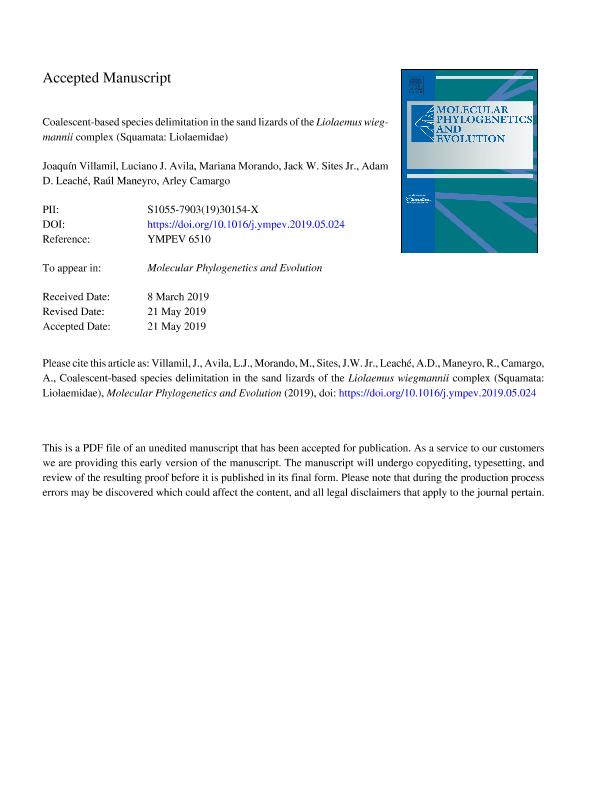Artículo
Coalescent-based species delimitation in the sand lizards of the Liolaemus wiegmannii complex (Squamata: Liolaemidae)
Villamil, Joaquín; Avila, Luciano Javier ; Morando, Mariana
; Morando, Mariana ; Sites, Jack W.; Leaché, Adam D.; Maneyro, Raúl; Camargo Bentaberry, Arley
; Sites, Jack W.; Leaché, Adam D.; Maneyro, Raúl; Camargo Bentaberry, Arley
 ; Morando, Mariana
; Morando, Mariana ; Sites, Jack W.; Leaché, Adam D.; Maneyro, Raúl; Camargo Bentaberry, Arley
; Sites, Jack W.; Leaché, Adam D.; Maneyro, Raúl; Camargo Bentaberry, Arley
Fecha de publicación:
09/2019
Editorial:
Academic Press Inc Elsevier Science
Revista:
Molecular Phylogenetics and Evolution
ISSN:
1055-7903
e-ISSN:
1095-9513
Idioma:
Inglés
Tipo de recurso:
Artículo publicado
Clasificación temática:
Resumen
Coalescent-based algorithms coupled with the access to genome-wide data have become powerful tools forassessing questions on recent or rapid diversification, as well as delineating species boundaries in the absence of reciprocal monophyly. In southern South America, the diversification of Liolaemus lizards during the Pleistocene is well documented and has been attributed to the climatic changes that characterized this recent period of time. Past climatic changes had harsh effects at extreme latitudes, including Patagonia, but habitat changes at intermediate latitudes of South America have also been recorded, including expansion of sand fields over northern Patagonia and Pampas). In this work, we apply a coalescent-based approach to study the diversification of the Liolaemus wiegmannii species complex, a morphologically conservative clade that inhabits sandy soils across northwest and south-central Argentina, and the south shores of Uruguay. Using four standard sequence markers (mitochondrial DNA and three nuclear loci) along with ddRADseq data we inferred species limits and a time calibrated species tree for the L. wiegmannii complex in order to evaluate the influence of Quaternary sand expansion/retraction cycles on diversification. We also evaluated the evolutionary independence of the recently described L. gardeli and inferred its phylogenetic position relative to L. wiegmannii. We find strong evidence for six allopatric candidate species within L. wiegmannii, which diversified during the Pleistocene. The Great Patagonian Glaciation (∼1 million years before present) likely split the species complex into two main groups: one composed of lineages associated with sub-Andean sedimentary formations, and the other mostly related to sand fields in the Pampas and northern Patagonia. We hypothesize that early speciation within L. wiegmannii was influenced by the expansion of sand dunes throughout central Argentina and Pampas. Finally, L. gardeli is supported as a distinct lineage nested within the L. wiegmannii complex.
Palabras clave:
DDRADSEQ
,
BAYES FACTOR SPECIES DELIMITATION
,
SPNS
,
SPECIES TREE
Archivos asociados
Licencia
Identificadores
Colecciones
Articulos(IPEEC)
Articulos de INSTITUTO PATAGONICO PARA EL ESTUDIO DE LOS ECOSISTEMAS CONTINENTALES
Articulos de INSTITUTO PATAGONICO PARA EL ESTUDIO DE LOS ECOSISTEMAS CONTINENTALES
Citación
Villamil, Joaquín; Avila, Luciano Javier; Morando, Mariana; Sites, Jack W.; Leaché, Adam D.; et al.; Coalescent-based species delimitation in the sand lizards of the Liolaemus wiegmannii complex (Squamata: Liolaemidae); Academic Press Inc Elsevier Science; Molecular Phylogenetics and Evolution; 138; 9-2019; 89-101
Compartir
Altmétricas



